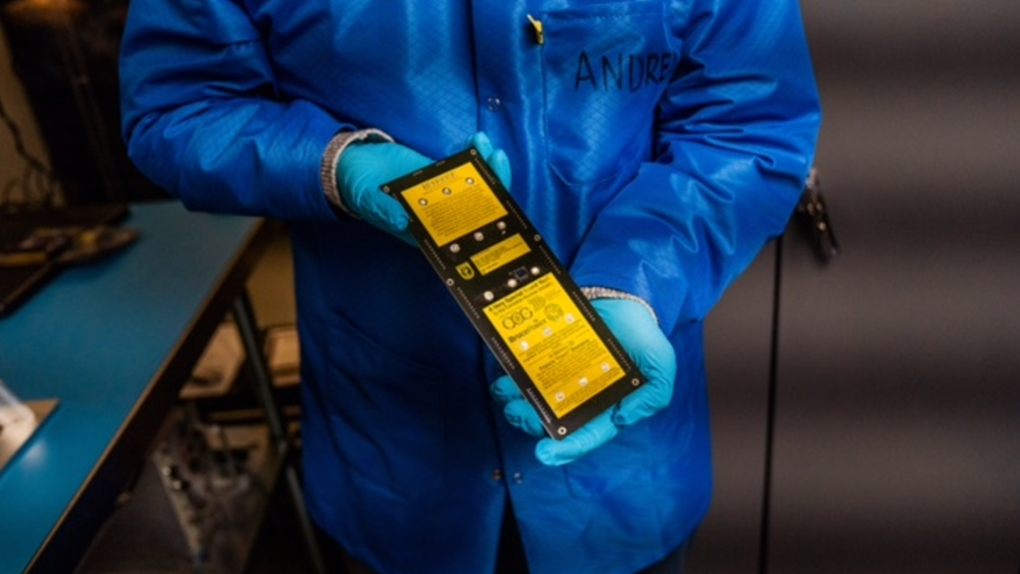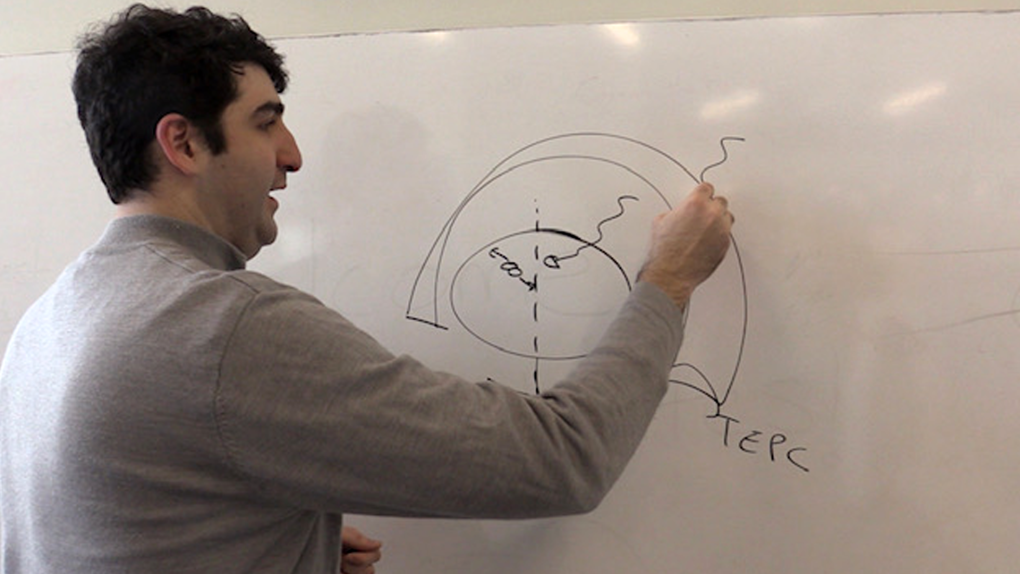Bruce County designed satellite headed to space
Dr. Eric Johnston is preparing to launch a satellite he helped create at the Nuclear Innovation Institute in Port Elgin, Ont., into space.
“For the last year and half, there was not the actual equipment that’s going to space, but the prototypes of them, being developed in our houses here in town,” said Johnston, the Nuclear Innovation Institute’s Chief Innovation Officer
Johnston, Dr. Andrei Hanu, a Senior Scientist at Bruce Power, and McMaster University’s Dr. Soo-Hyun Byun, have spent the past eight years designing and creating a satellite that could measure radiation in space.
To make trips to Mars possible, astronauts need to know what kind and dose of radiation they would endure.
The radiation detection device at the core of the satellite mimics human fat tissue, absorbing space radiation and reporting those measurements back to Earth.
“The Nuclear Innovation Institute and Bruce Power actually funded the development of the radiation detector itself, which has some use here terrestrially as well. So, it was like, ‘oh, we can create this really cool instrument that we’re going to use in space, and will bring us towards a detector that we can also use here on Earth’,” said Johnston.
The NEUDOSE nano-satellite, no bigger than a slice of bread, is hitching a ride aboard a Space X rocket to the International Space Station next week.
 A NEUDOSE satellite, partially created and designed by two Bruce County scientists and funded in part by Bruce Power and the Nuclear Innovation Institute, is being sent to space on a Space X rocket on Tuesday, March 14, 2023. (Source: Kayla Da Silva/McMaster University)
A NEUDOSE satellite, partially created and designed by two Bruce County scientists and funded in part by Bruce Power and the Nuclear Innovation Institute, is being sent to space on a Space X rocket on Tuesday, March 14, 2023. (Source: Kayla Da Silva/McMaster University)
Johnston and his fellow scientists are heading to Florida to watch their creation launch into orbit.
“It’ll be a few months before it actually gets deployed. It’ll get sort of thrown out the back, for lack of a better term, from the space station, and that’s how it gets its orbit,” said Johnston.
Johnston says the NEUDOSE satellite will spend between nine months and two years in space transmitting radiation data back to McMaster, when it reaches line of sight, as it circles the globe.
“It’s just awesome that, that kind of work, can happen in a community like ours, of 17,000 residents, in rural Ontario. It’s amazing to think that we can be part of sending people to Mars,” said Saugeen Shores Mayor Luke Charbonneau.
The NEUDOSE satellite heads to the International Space Station on Tuesday, March 14. Shortly thereafter, a piece of technology created, designed, and funded in Bruce County, will be floating outside Earth’s atmosphere. Johnston said, he can’t wait.
 Dr. Eric Johnston working on scientific theories at the Nuclear Innovation Institute in Port Elgin, Ont., where he helped design and create the NEUDOSE satellite that will be entering space on Tuesday, March 14, 2023. (Scott Miller/CTV News London)
Dr. Eric Johnston working on scientific theories at the Nuclear Innovation Institute in Port Elgin, Ont., where he helped design and create the NEUDOSE satellite that will be entering space on Tuesday, March 14, 2023. (Scott Miller/CTV News London)
CTVNews.ca Top Stories

'We can live our lives again without worrying': Ontario man relieved after insurance company agrees to pay $620,000 hospital bill
An Ontario man who received a $620,000 medical bill from a Florida hospital is now relieved that his insurance company has reversed its decision and decided to pay the bill.
Mark Carney tells Jon Stewart the Liberal party has 'a chance' after Trudeau's resignation
Days ahead of his expected Liberal leadership campaign launch, former Bank of Canada and Bank of England governor Mark Carney says Prime Minister Justin Trudeau's decision to step down boosts the party's chance in the next general election.
'It's not going to be good': Ford says Trump's tariffs could cost Ontario 500,000 jobs
Premier Doug Ford says U.S. president-elect Donald Trump’s promised tariffs on Canadian goods could result in the loss of 500,000 jobs in Ontario, creating the need for billions of dollars in stimulus spending.
Curler Briane Harris not at fault for anti-doping rule violation, provisional ban lifted
Canadian curler Briane Harris is eligible to return to the sport after an absence of nearly one year.
Calgary homeowner faces challenge after property assessment jumps 60%
Stan Valant, a long-time resident of Calgary's Silver Springs, is baffled by the city's recent assessment of his bi-level home.
Harm reduction advocates hope high court will 'clarify' Canada's 'Good Samaritan' law
Canada's Good Samaritan law, which is meant to shield people from arrest after they seek help for someone in medical distress, is under spotlight in the Supreme Court of Canada.
Michelle Obama will not attend Trump's inauguration
Former first lady Michelle Obama will skip the inauguration of president-elect Donald Trump, the second time in two weeks that she is not attending a gathering of former U.S. leaders and their spouses.
Why is Spain considering a 100 per cent tax on homes bought by non-EU residents?
Spain is planning a raft of measures to address its brewing housing crisis, including an up to 100% tax on properties bought by non-European Union residents.
Hamas has accepted a draft agreement for a Gaza ceasefire and the release of hostages, officials say
Hamas has accepted a draft agreement for a ceasefire in the Gaza Strip and the release of dozens of hostages, two officials involved in the talks said Tuesday. Mediator Qatar said Israel and the Palestinian militant group were at the "closest point" yet to sealing a deal that would bring them a step closer to ending the war.
































